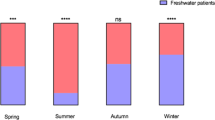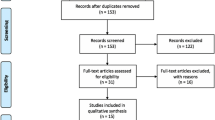Abstract
This study summarized the available evidence on the differences in volume, density, electrolyte concentration, and total proteins in paranasal sinus fluid between freshwater and saltwater drowning victims. A systematic search was conducted in electronic databases and gray literature, resulting in the inclusion of five studies with 234 drowning victims (92 saltwater incidents and 142 freshwater incidents). Meta-analyses using the inverse-of-variance method and a random-effects model were performed, reporting effect sizes as standardized mean differences (SMD) with 95% confidence intervals (CI). The findings showed a significantly higher sinus density in saltwater drowning cases compared to freshwater drowning cases (SMD 0.91, 95% CI 0.50 to 1.32). However, no significant differences were observed in sinus fluid volume. Saltwater drowning victims exhibited higher electrolyte concentrations (sodium: SMD 3.77, 95% CI 3.07 to 4.48; potassium: SMD 0.78, 95% CI 0.07 to 1.49; chloride: SMD 3.48, 95% CI 2.65 to 4.31; magnesium: SMD 4.01, 95% CI 3.00 to 5.03) and lower total protein concentrations (SMD − 1.20, 95% CI − 1.82 to − 0.58) in sinus fluid compared to freshwater drowning victims. This meta-analysis highlights the importance of analyzing the characteristics and composition of sinus fluid in forensic investigations of drowning cases. While no differences were found in sinus fluid volume, saltwater drowning victims exhibited higher sinus density, elevated electrolyte concentrations, and lower total protein concentrations compared to freshwater drowning victims.





Similar content being viewed by others
Data availability
Data are available from the authors upon reasonable request.
References
van Beeck EF, Branche CM, Szpilman D, Modell JH, Bierens JJLM. A new definition of drowning: towards documentation and prevention of a global public health problem. Bull World Health Organ [Internet]. 2005;83:853–6. Available from: http://www.ncbi.nlm.nih.gov/pubmed/16302042.
Bierens JJLM, Lunetta P, Tipton M, Warner DS. Physiology of drowning: a review. Physiology. 2016;31:147–66. Available from: https://www.physiology.org/doi/10.1152/physiol.00002.2015.
Byard RW, Cains G, Simpson E, Eitzen D, Tsokos M. Drowning, haemodilution, haemolysis and staining of the intima of the aortic root—preliminary observations. J Clin Forensic Med. 2006;13:121–4. Available from: http://www.ncbi.nlm.nih.gov/pubmed/16488651.
Kawasumi Y, Usui A, Sato Y, Sato Y, Daigaku N, Hosokai Y, et al. Distinction between saltwater drowning and freshwater drowning by assessment of sinus fluid on post-mortem computed tomography. Eur Radiol. 2016;26:1186–90.
Shen X, Liu Y, Xiao C, Zheng C, Huang J, Shi H, et al. Analysis of false-positive results of diatom test in the diagnosis of drowning-would not be an impediment. Int J Legal Med. 2019;133:1819–24. Available from: http://www.ncbi.nlm.nih.gov/pubmed/30770988.
Zivković V, Babić D, Nikolić S. Svechnikov’s sign as an indicator of drowning in immersed bodies changed by decomposition: an autopsy study. Forensic Sci Med Pathol. 2013;9:177–83. Available from: http://www.ncbi.nlm.nih.gov/pubmed/23269532.
Yajima D, Inokuchi G, Makino Y, Motomura A, Chiba F, Torimitsu S, et al. Diagnosis of drowning by summation of sodium, potassium, and chloride ion levels in sphenoidal sinus fluid: differentiating between freshwater and seawater drowning and its application to brackish water and bathtub deaths. Forensic Sci Int. 2018;284:219–25.
Schneppe S, Dokter M, Bockholdt B. Macromorphological findings in cases of death in water: a critical view on “drowning signs”. Int J Legal Med. 2021;135:281–91. Available from: http://www.ncbi.nlm.nih.gov/pubmed/33237456.
da Trindade RQ, Duarte Morais Vieira MG, Vieira RB, Vicentin-Junior CA, Damascena NP, Santiago BM, et al. The role of paranasal sinus fluid in determining drowning as the cause of death: a systematic review and meta-analysis. J Forensic Leg Med. 2023;99:102591. Available from: https://linkinghub.elsevier.com/retrieve/pii/S1752928X23001099.
Page MJ, Moher D, Bossuyt PM, Boutron I, Hoffmann TC, Mulrow CD, et al. PRISMA 2020 explanation and elaboration: updated guidance and exemplars for reporting systematic reviews. BMJ. 2021;n160. Available from: https://www.bmj.com/lookup/doi/10.1136/bmj.n160.
Stroup DF, Berlin JA, Morton SC, Olkin I, Williamson GD, Rennie D, et al. Meta-analysis of observational studies in epidemiology: a proposal for reporting. Meta-analysis Of Observational Studies in Epidemiology (MOOSE) group. JAMA. 2000;283:2008–12. Available from: http://jama.jamanetwork.com/article.aspx?doi=10.1001/jama.283.15.2008
Hozo SP, Djulbegovic B, Hozo I. Estimating the mean and variance from the median, range, and the size of a sample. BMC Med Res Methodol. 2005;5.
Cohen J. Statistical power analysis for the behavioral sciences. 2nd ed. NJ, Erlbaum: Hillsdale; 1988.
Higgins JPT, Thompson SG. Quantifying heterogeneity in a meta-analysis. Stat Med. 2002;21:1539–58. Available from: https://onlinelibrary.wiley.com/doi/10.1002/sim.1186.
Sugawara M, Ishiyama K, Takahashi S, Otani T, Koga M, Watanabe O, et al. Postmortem computed tomographic features in the diagnosis of drowning: a comparison of fresh water and salt water drowning cases. Jpn J Radiol. Springer Japan; 2019;37:220–9. Available from: https://doi.org/10.1007/s11604-018-0802-8.
Tanaka N, Kinoshita H, Jamal M, Takakura A, Kumihashi M, Miyatake N, et al. Detection of chlorine and bromine in free liquid from the sphenoid sinus as an indicator of seawater drowning. Leg Med. Elsevier Ireland Ltd. 2015;17:299–303. Available from: https://doi.org/10.1016/j.legalmed.2015.08.005.
Hayakawa A, Terazawa K, Matoba K, Horioka K, Fukunaga T. Diagnosis of drowning: electrolytes and total protein in sphenoid sinus liquid. Forensic Sci Int. Elsevier Ireland Ltd. 2017;273:102–5. Available from: https://doi.org/10.1016/j.forsciint.2017.02.017.
Lundemose SB, Jacobsen C, Jakobsen LS, Lynnerup N. Exact volumetric determination of fluid in the paranasal sinuses after drowning. J Forensic Radiol Imaging. 2015;3:111–6. Available from: https://linkinghub.elsevier.com/retrieve/pii/S2212478015000155.
Tagami K, Uchida S. Concentrations of chlorine, bromine and iodine in Japanese rivers. Chemosphere. 2006;65:2358–65. Available from: https://linkinghub.elsevier.com/retrieve/pii/S0045653506005698.
Sharqawy MH, Lienhard JH, Zubair SM. Thermophysical properties of seawater: a review of existing correlations and data. Desalin Water Treat. 2010;16:354–80. Available from: http://www.tandfonline.com/doi/abs/10.5004/dwt.2010.1079
Byard RW. Putrefaction: an additional complicating factor in the assessment of freshwater drownings in rivers. J Forensic Sci. 2018;63:899–901. Available from: http://www.ncbi.nlm.nih.gov/pubmed/28810068.
Author information
Authors and Affiliations
Contributions
All authors contributed to the conception and design of the study. Material preparation, data collection, and analysis were performed by MGDMV, RQdT, BMS, and PRM-F. The first draft of the manuscript was written by MGDMV, RQdT, MCS, and PRM-F; and all authors commented on the previous versions of the manuscript. All authors have read and approved the final manuscript.
Corresponding author
Ethics declarations
Conflict of interest
The authors declare no competing interests.
Additional information
Publisher's Note
Springer Nature remains neutral with regard to jurisdictional claims in published maps and institutional affiliations.
Rights and permissions
Springer Nature or its licensor (e.g. a society or other partner) holds exclusive rights to this article under a publishing agreement with the author(s) or other rightsholder(s); author self-archiving of the accepted manuscript version of this article is solely governed by the terms of such publishing agreement and applicable law.
About this article
Cite this article
Vieira, M.G.D.M., da Trindade, R.Q., Vieira, R.B. et al. Differences in volume, density, electrolyte concentration, and total proteins in the fluid of the paranasal sinuses of freshwater and saltwater drowning victims: a systematic review and meta-analysis. Forensic Sci Med Pathol (2023). https://doi.org/10.1007/s12024-023-00761-9
Accepted:
Published:
DOI: https://doi.org/10.1007/s12024-023-00761-9




